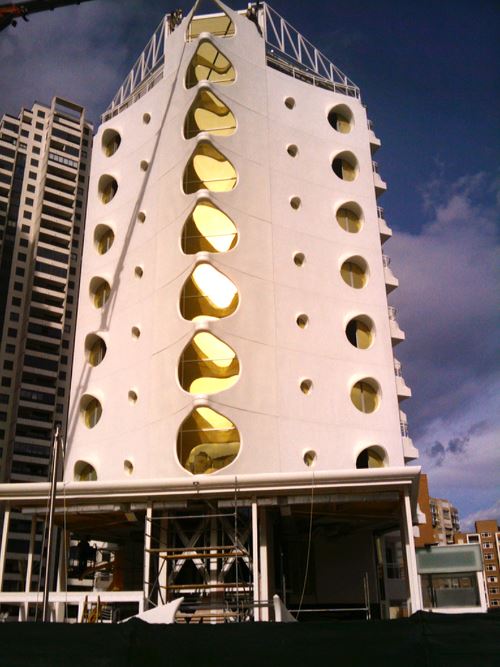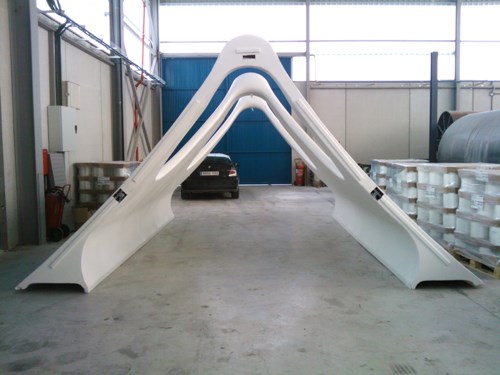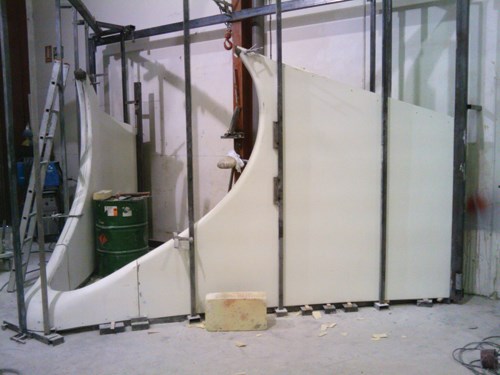Fiberglass façade: GRP shapes modernize hotel in Spain
The exterior of the Vista Riviera hotel in Benidorm, Spain, has been transformed with a modern twist, thanks to the fiberglass expertise of Miraplas SL (Monforte del Cid, Spain).
The exterior of the Vista Riviera hotel in Benidorm, Spain, has been transformed with a modern twist, thanks to the fiberglass expertise of Miraplas SL (Monforte del Cid, Spain). Designed by Spanish architect Vicente Peidró, the new façade is made up of large molded fiberglass panels produced with a striking white gel coat finish. Assembly and installation of the parts was simplified with Crystic Crestomer structural adhesives from Scott Bader Company Ltd. (Wollaston, Northamptonshire, U.K.).
At its 44,000m2 (473,612 ft2) composites facility in the south of Spain, Miraplas has long specialized in the manufacture of tanks and other parts for wastewater treatment, water purification and desalination plants. More recently, it has expanded into wind blades and complex parts for industrial and building/construction applications. For the hotel façade, parts were produced primarily by light resin transfer molding (LRTM) and hand layup under the direction of José Manuel Bey Garcia, an independent consultant in RTM processing.
The most challenging aspect was the production of the nine large, 22.5m2 (242.2 ft2) curved triangular/elliptical sections. Bey Garcia’s solution was to produce eight separately molded parts, each made of 5-mm/0.2-inch thick glass fiber-reinforced polyester (GRP) laminate, and bond them together. The laminate features an isophthalic gel coat backed by three layers of chopped glass mat impregnated with isophthalic resin. Once molded, the eight pieces were accurately positioned in a metal bonding jig specially designed by Miraplas to hold all the parts in position. Crystic Crestomer 1152PA urethane acrylate structural adhesive, designed for bulk application with a 45-minute open time (based on 2 percent Butanox M50 MEKP catalyst at 25°C/77°F), was applied via pneumatic gun. The steel frames used to mechanically fix the GRP sections to the hotel’s exterior wall also were bonded into place with the same adhesive. In some confined areas, however, smaller handheld guns were used, with 380-ml cartridges of Crestomer Advantage 30 urethane acrylate (30 minute open time at 1:1 ratio).
“Having used Crystic Crestomer adhesives for many years, I was able to recommend their use for this project with great confidence,” contends Bey Garcia. They “eliminated fastener weight, a benefit when building loads were calculated.” Moreover, production efficiency was improved with the pneumatic application guns.
Related Content
-
Combining multifunctional thermoplastic composites, additive manufacturing for next-gen airframe structures
The DOMMINIO project combines AFP with 3D printed gyroid cores, embedded SHM sensors and smart materials for induction-driven disassembly of parts at end of life.
-
Plant tour: Airbus, Illescas, Spain
Airbus’ Illescas facility, featuring highly automated composites processes for the A350 lower wing cover and one-piece Section 19 fuselage barrels, works toward production ramp-ups and next-generation aircraft.
-
Optimizing a thermoplastic composite helicopter door hinge
9T Labs used Additive Fusion Technology to iterate CFRTP designs, fully exploit continuous fiber printing and outperform stainless steel and black metal designs in failure load and weight.















